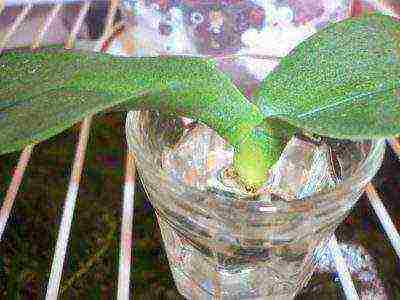Content
- 1 What determines the yield
- 2 Stage 1. Making compost for mushrooms
- 3 Stage 2. Composting and caring for mycelium
- 4 Stage 3. Ripening of the crop
- 5 Stage 4. Harvesting
- 6 Video: growing mushrooms at home
- 7 How to grow champignon mushrooms at home in the basement
- 8 Interesting video: Making compost for growing mushrooms for sale
- 9 Growing mushrooms at home in bags
Champignons are grown in the beds in spring and summer, and in the fall and winter at home, in greenhouses, premises, cellars, greenhouses.
The cellar is an ideal place for growing mushrooms. To get a great harvest, you need to prepare the nutrient substrate, prepare the room, and control the humidity and temperature.
Substrate preparation
You can use horse manure with bedding, put it in a cone shape and pour water on top. Humidity should be around 60%.
Next, you need to add 3 kg of ammonium sulfate per 1 ton of manure to the substrate. Cover the pile with straw or mats so that the manure starts to warm up and the water does not evaporate. Then wait 5-7 days and use a pitchfork to mix the manure together with gypsum per 1 ton of manure - 4 kg of gypsum.
Also, the substrate can be prepared from wheat straw with chicken dung. For 1 ton of straw, it is necessary to add approximately 300-400 kg of chicken manure, 60 kg of gypsum and 30 kg of urea.
To begin with, straw is mixed with 120-150 kg of chicken manure and 25 kg of urea (in solution). Then it is sprayed with water for 7-10 days. Then the straw is piled up and re-layered with droppings, about 250-280 kg per 1 ton of dry straw.
Soil laying
Usually mushrooms are grown in a cellar on an earthen floor or in wooden boxes. The ridges are made with a size of 70x70 cm. The manure is laid in a thick layer of about 40 cm, then it is compacted with a rammer to 25-30 cm. The side ridges are compacted with a shovel.
Boxes are most often used with a length of 100 cm and a width of 50 cm. They are stuffed with manure and compacted to 20-25 cm.
Planting mycelium
A temperature of 26-28 ° C at a depth of 4-5 cm is considered acceptable for planting champignons.
For growing mushrooms, 500 g of compost mycelium or 400 g of champignon grain spores per 1 square meter are used.
The "seeds" must be placed in the substrate. We make the deepening no more than 5 cm, the distance from each other is 15-20 cm, add a little compost mycelium to each depression. If you have champignon spores available, then they must be scattered over the surface. Little by little, the strings of mycelium can grow over the substrate.
During the growth of mycelium, you need to maintain the humidity in the cellar at 65-85% so that your substrate does not dry out. The temperature must be maintained at 22-28 ° C. The mushroom filaments will be able to actively spread in 9-14 days. After that, the surface of the substrate should be covered with a small amount of soil (2-4 cm, a mixture of limestone 1 part, soil 3-4 parts and peat 4-5 parts) and wait another 4-6 days. Spray with water periodically.
Forcing fruiting bodies
When the incubation period is over, the temperature in the cellar should be lowered to 14-16 degrees. The first harvest can be taken in 3-4 months. Take them off only if the bottom of the cap is covered with a white film, and the brown plates are not yet visible. The mushrooms are not cut, but carefully twisted from the planting site.
The place where the mushroom grew must be sprinkled with soil a little. Champignons will grow vigorously within 12-16 days. If the created conditions and compost were good enough for them, then during this time 4-8 harvests of mushrooms can be removed.
How to grow champignons at home - video
Champignons are considered the most common types of mushrooms, so there is no need to advertise them further.The product is widely used in cooking, on its basis first and second courses, canned snacks, salads are prepared. Due to their high protein content, mushrooms are an excellent source of protein. Experienced gardeners prefer to grow mushrooms on their own, but the procedure has a number of features. To fully comply with the technology, you must adhere to the step-by-step instructions.
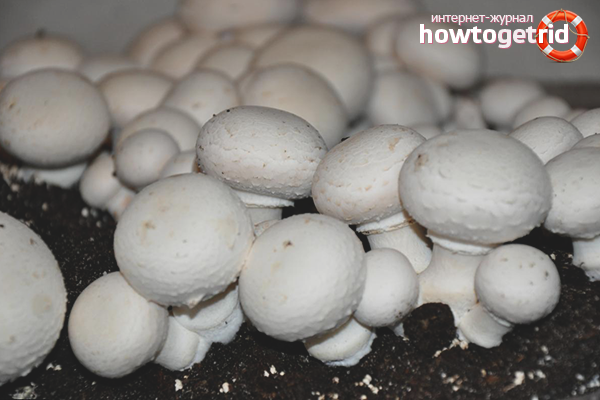
What determines the yield
- The main factor affecting the yield is the implementation of the correct microclimate, in which the ears will begin to bear fruit. Also of great importance is timely watering, proper compost (correctly selected soil composition), resistance to external factors, diseases, pests.
- If you create optimal conditions, you can easily grow mushrooms all year round. First you need to choose a room that has a temperature regime of 14-24 degrees. It is not necessary to take the starting place, the main thing is the ability to maintain the temperature (the presence of a heater or, on the contrary, a split system). In this case, the air humidity should not exceed 90% (the ideal option is considered to be 80-85% humidity).
- An equally important factor in ensuring the proper yield is the circulation of the air flow. Make sure that the selected area is thoroughly ventilated, it is important to provide a supply of fresh air. Otherwise, the excess carbon dioxide released during the cultivation of mushrooms will result in a disproportionate stem (it will stretch unevenly).
- A positive feature of growing mushrooms at home is the complete lack of lighting. It does not matter, so the procedure can be carried out in a cellar, basement or in a covered shed, where the sun's rays do not penetrate. If you wish, you can use the darkened free corners located in the garage or greenhouse. As mentioned earlier, the main thing is to provide humidity and the required temperature in the absence of light.
- Since mushrooms are grown in a humid environment, it is important to immediately prepare for the possible spread of bacteria. Treat the selected room in advance with a composition of copper sulfate and lime, as well as formalin. Disinfection will kill existing microorganisms, so the likelihood of spreading diseases will decrease to a minimum.
- If you plan to grow champignons in the summer or autumn, consider the option of carrying out the procedure at your summer cottage. Pick up a dark place in your backyard field, select a separate bed, cover the soil. Cover the mycelium with roofing material (can be replaced with polyethylene) to exclude the possibility of drying out or, on the contrary, excessive moisture. Such a simple move will provide the proper microclimate.
how to grow oyster mushrooms correctly
Stage 1. Making compost for mushrooms
- Compost refers to the special soil that must be prepared in order to obtain a full harvest of mushrooms. It is worth remembering that the soil is filled with organic compounds that play a major role in the cultivation of mushrooms, so you cannot save on fertilizer.
- Composting is rightfully considered the most time-consuming process, the final result depends on it. Mushrooms, in particular champignons, are highly dependent on the composition of the soil, for this reason, proportions must be observed. Correctly compiled soil consists of one part of moistened straw and 4 parts of horse manure (the proportion of straw to manure is 1: 4).
- Spread the compost in layers, alternating between the two. For maximum effect, line small amounts of urea or superphosphate between the rows. Champignons will grow faster if you use horse manure specifically.However, in its absence, it is allowed to alternate straw with chicken droppings or processed waste products of other animals.
- The lined compost for mushroom ripening should receive air from all sides, for this reason it is not recommended to lay it on the ground. Make sure that the ground is covered with a canopy, do not allow direct ultraviolet radiation or heavy rainfall. Of course, the compost must be moist, but excess water will interfere with fermentation.
- In order to get high quality compost at the output, prepare a heap for maturation. Its dimensions are approximately equal to 1.5 m. In width, 1.5 m. In length and 1.5 m. In height. It is this ratio that will ensure proper combustion. Do not compost in small quantities, as you need large amounts to complete fermentation.
- If we talk about the place where the compost is made, try to carry out manipulations outdoors. As a result of the fermentation of the substrate, ammonia and carbon dioxide are released. Provide good air flow and ventilation when composting indoors.
- The maturation of the compost varies from 18 to 20 days. Stir and moisten the contents of the pile every 5-6 days to ensure proper combustion. During the first mixing process, add crushed lime to the compost. During the second procedure - superphosphate, then crushed gypsum or alabaster is poured.
- Compost is prepared by fermentation, so its temperature sometimes reaches 53-70 degrees. At the end of the combustion process, the indicator drops to a level of 21-25 degrees. The readiness of the compost can be judged by the smell, the ammonia stench disappears. The finished soil has a brownish tint, an elastic structure (when squeezed, it returns to its original position). The composition should not stick to the hands, while the straw breaks easily and has a soft structure.
how to grow a truffle at home
Stage 2. Composting and caring for mycelium
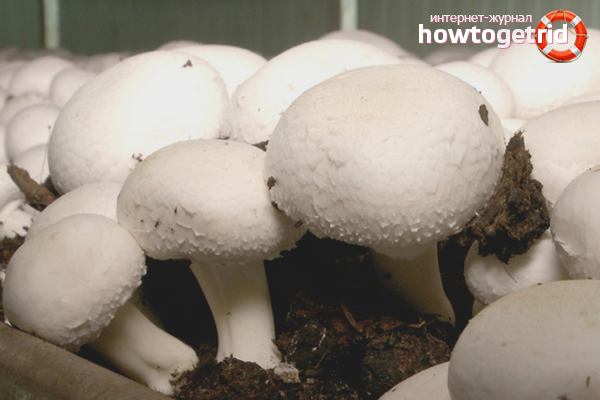
- Once the compost has been prepared, you can start laying it. Choose containers for growing mushrooms, spread the mass so that its height does not exceed 22 cm. Wooden boxes, bags, racks or plastic containers can be used as containers.
- If we talk about the seed, it is called mycelium. The composition is grown in a laboratory way, so it will not work to produce it yourself. You have to buy the product. The mycelium can be compost and grain.
- The first type is characterized by a long storage time (about 10-12 months at a temperature of 0 degrees). You will need about 500 gr. compost mycelium per 1 sq. m. soil. The grain composition is more efficient and yields better. For 1 sq. m. of soil must be added 330-350 gr. mycelium. At the same time, the product retains its properties for six months, you can keep it in the refrigerator.
- To sow, put the required amount of mycelium in the compost (lift it up with a layer), deepen the seed by 5 cm. The location of the holes is a checkerboard, each depression should be made at a distance of 25-30 cm from each other.
- If all the conditions are met (the temperature of the compost is about 20 degrees, the air humidity is about 80%), the mycelium will develop in 15-20 days. During the ascent of the sowing composition, it is necessary to constantly moisten the soil and monitor the temperature regime of the substrate (the indicator should not rise above 40 degrees). Otherwise, the mycelium will die. To maintain moisture, cover with burlap or plastic.
- If you grow mushrooms in your summer cottage, there is no possibility to regulate temperature and humidity. When the indicators decrease, cover the beds tightly with roofing material or film.
how to make mushroom soup from frozen mushrooms
Stage 3. Ripening of the crop
- As mentioned earlier, mycelium grows in about 3 weeks. You will know about the completion of the process by the emerging spider web with a silvery tint, it will come out to the surface of the soil. At this point, it is necessary to reduce the temperature to 13-16 degrees and sprinkle the cobweb 5 cm of the casing layer. The mixture consists of lime powder and peat, it causes an alkaline reaction.
- To ensure productive ripening of the crop, throughout the entire process, maintain the temperature within 13-16 degrees, the humidity should be about 85%, and do not forget about good ventilation. Soil irrigation is carried out by drip with the help of scattering devices that ensure uniform spraying. Such a move will not compact the substrate, but it will fully moisturize it.
- If champignons grow in a summer cottage, protect the soil from direct ultraviolet radiation, and also avoid waterlogging. The sun will dry out the compost or get very hot. At the same time, torrential rains will compress the soil, as a result of which there will be a large load on the mycelium (its development will slow down or stop altogether).
Stage 4. Harvesting
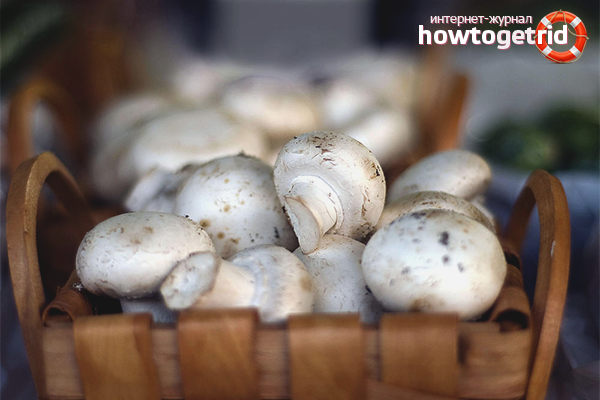
- The first crop of mushrooms can be harvested after 3-4 weeks. The peel will tell you about the readiness of the composition, it will begin to burst in the lower section of the mushroom cap. Champignons have a tendency to ripen in stages, the first harvest is the largest, then the wave subsides.
- To collect mushrooms, twist them counterclockwise, then carefully remove from the ground. Sprinkle the resulting hole with moist soil after removing the fungus. Rotate gently, otherwise you will damage the mycelium layer and young mushroom cobs.
- Collect all specimens, even those that are sick or small in size. Such a move will save the subsequent harvest from pests, as a result of which the fruit bodies will begin to develop many times faster.
- Throughout the entire fruiting stage, spray the room with potassium permanganate, diluted until a raspberry hue appears. You can also use lime at your convenience. Such a move will prevent pathogens from developing in humid conditions.
- In terms of quantity, from 1 sq. m. you will collect about 6-13 kg. champignons. For 2-3 months, the mycelium will bear fruit about 7 times, after which the yield will drop sharply. It is forbidden to reuse the compost, it can be used to fertilize the vegetable garden and orchard.
Prepare compost for growing mushrooms, purchase mycelium. Maintain the required temperature and moisture content of the soil, harvest in stages. Do not use the used compound a second time. After harvesting, disinfect the mushroom containers and the room in which they were grown.
how to store dried mushrooms at home
Video: growing mushrooms at home
If you want to start your own business, we suggest you find out the easiest way, how to grow mushrooms at home for sale... These mushrooms are widely used in various dishes, so you can grow them for your family or try to market them. Step-by-step instructions and a video on growing mushrooms at home will help you master different technologies and get a good mushroom harvest in your own basement.
Find out: How to grow strawberries from seed for seedlings at home
How to grow champignon mushrooms at home in the basement
To start growing mushrooms in the basement, you need to start by determining the method, because at the moment the following technologies are used:
- in bags;
- in the beds;
- in containers;
- on shelves;
- in Dutch.
Each of these simple ways to grow mushrooms at home has its pros and cons, so the choice depends on the size of the basement, the temperature conditions in it, and the plans to get the mushrooms for sale.
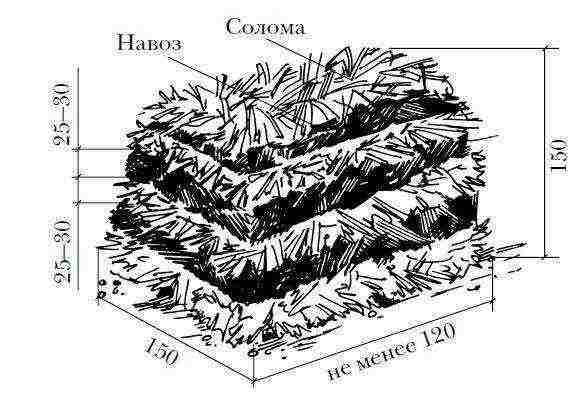
Scheme of preparing the substrate for burnout
It is important to heat it before laying the mycelium, then it will feel a little springy to the touch. It should be borne in mind that the mycelium can be compost and grain. The latter can be stored well in the refrigerator for up to 6 months and for planting 1 sq. m you will spend 0.35 kg, the compost mycelium is stored for almost a year, but at the same time its costs for planting per 1 sq. m will be 0.5 kg.
Learn more about growing mushrooms at home in the basement we suggest watching in the video:
Knowing how to properly grow mushrooms in your basement can help you grow a good harvest of mushrooms at home. Experiment with simple and new ways.
Interesting video: Making compost for growing champignons for sale
Growing mushrooms at home in bags
One of the most common technologies is growing mushrooms in plastic bags. This is the simplest method that is widely used in European countries to obtain mushrooms in large quantities. Polymer bags can have a capacity of 25 and 35 liters, while you can take a smaller volume for growing mushrooms in an apartment.
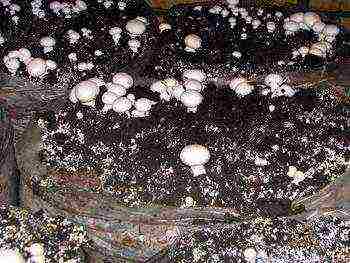
Photo of mushrooms in bags
Placing mycelium bags in the basement or garage plays an important role. To do this, use simple methods: parallel and chess. The disadvantage of the first method is that about 20% of the usable area is lost, therefore, a checkerboard arrangement of bags is more often used. Any space loss can be compensated by using deeper plastic bags.
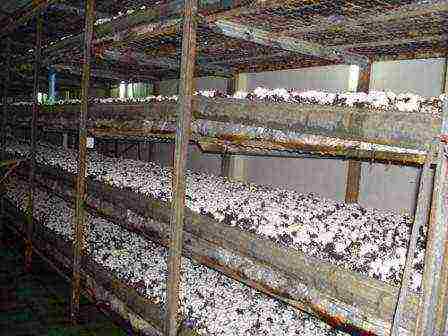
Photo of growing mushrooms in boxes
To carry out growing mushrooms at home in bags, you should follow these steps:
- Soil preparation... To do this, you need to mix black soil, sunflower husk and mullein in a ratio of 3: 1: 1. Then add 1.5 parts straw and 6.5 parts horse dung. After that, the substrate is filled with hot water and left to rot for 20 days.
- Bagging... After rotting, the soil is dried and put into prepared bags. The land is watered, since good humidity is important for growing mushrooms at home.
- Sowing mycelium... In each bag, make holes in a checkerboard pattern and sow the mycelium. The holes should be of such a diameter that the earth does not spill out. Place mushroom seeds in each hole.
Growing champignon mushrooms at home in bags is quite convenient, while you will get a good and stable harvest for small and large sales.
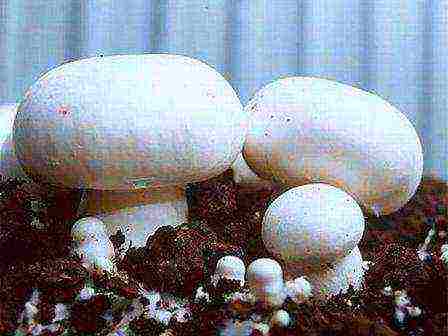
Photo of champignons for sale
Growing champignons in an apartment
If you want to start growing mushrooms in an apartment, then you will have to prepare compost in the garage or in the country, make aluminum racks with shelves on which containers with mushrooms will be placed.
Scheme of the Dutch champignon
You will need to make 75x50x14 cm boxes and drill a few small holes in the bottom for ventilation. The upper part and side walls of the boxes are covered with cardboard, and the front part should not be closed at all, since after sowing it will need to be wrapped in polyethylene. After that, compost is poured into the boxes, the mushrooms are sown. Cover everything with newspapers on top.
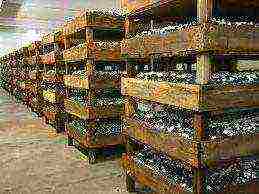
Photo of growing mushrooms in racks
After 15-20 days, remove all the insulating material, pour black soil into the boxes on top and pour. Install a fan nearby so that when growing mushrooms in an apartment, the soil does not mold, and the mushrooms do not stretch out. In this way, you can get up to 2 kg of mushrooms from one box.
We recommend reading: How to grow oyster mushrooms at home step by step
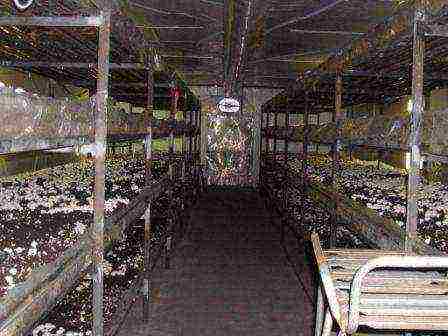
Growing champignons in a garage on a garden bed for sale
When choosing a method for growing mushrooms, you need to assess the availability of free space. If your garage has an empty basement, then you can try growing mushrooms in the garden beds.For this, it is important to properly prepare the soil and maintain optimal temperature conditions for the growth of mushrooms.
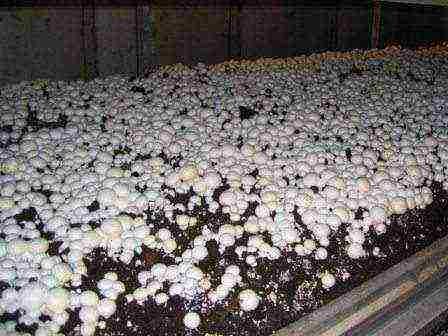
Photo of champignons in the beds
Growing mushrooms in the garden at home is carried out as follows:
- Level the floor. The beds should be located on a level surface.
- Place plastic wrap. Since it is usually cool in the basement in the garage, you need to take care that the moisture does not evaporate.
- Cover the garden with compost. The fertilizer layer should not exceed 40 cm.
- Spread out the seed. Plant the mushroom mushroom in the prepared furrows in the garden bed. You can try just scattering the seeds and then covering them with a little more compost.
- Water. Water the beds with mushrooms abundantly for 3 months so that the compost is well moistened, then the mycelium will actively develop.
A simple way to grow mushrooms in the garden beds is in demand among 80% of summer residents and beginners. With minimal costs, you can get a good harvest.
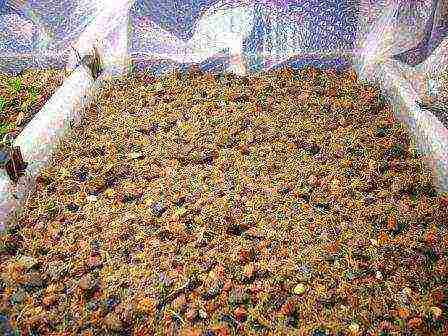
Photo of preparing compost for mushrooms
Growing champignons at home for beginners with video
If you decide to take up the cultivation of champignons at home as a business, then evaluate the profitability:
Business payback: up to 9 months
Investments: up to 100 thousand rubles, depending on the volume
Sales market occupancy: up to 40%
Relevance: for cities and villages with any population size
Watch a useful video on how to grow mushrooms for novice mushroom growers:
Now you have learned about all the easy ways to grow mushrooms at home for sale. Choose the right technology and get started in the lucrative mushroom farming industry.
Champignons have long won the first place in the preparation of mushroom dishes. They are uncomplicated in cooking and have a pleasant sweetish taste. We are used to buying in supermarkets, but mushrooms are easy to grow at home, and if you wish, you can create your own business.
Have you decided to grow mushrooms yourself? First of all, decide on a place for production, since the technology directly depends on it, for example: in the country, in the basement of a private house, in a rented room. Then study planting and care technologies, possible diseases, temperature conditions, and others.
The correct technology for growing champignons
For planting, you will need grain or compost mycelium. With a properly planted mycelium, correctly selected temperature and humidity, it will be possible to harvest the crop in the first year.
Grain mycelium in the ground
When planting grain mycelium, make grooves in the ground no more than 0.3 m deep and about 0.5-0.6 m wide. In this state, leave the dug pits for 2-3 days to normalize the temperature. Then proceed with the inception of the mycelium. It is better to place the body of the mushroom in a checkerboard pattern at a distance of at least 20 cm.
Compost view
If the choice fell on the compost type, the technology is somewhat different. Lay drainage at the bottom of the mini-pits, and on top - compressed compost, in which place the mycelium and cover it with it. If everything is done correctly and the mycelium was of high quality, a week later you will see new branches of the mycelium.
3 weeks after successful planting, spread a layer of wet soil over the beds. It is important to ensure that the layer thickness does not exceed 25-30 cm, otherwise the formation of mushroom bodies may be blocked. The soil should contain peat, chalk and sod soil, which will provide the necessary acidity for development.
Provide room ventilation and the required air humidity. If we talk about specific numbers, then for the activation of spores the optimal temperature is 24-28 ° C, and for the growth of mushrooms - 16-18 ° C.
Install temporary shelters or cover the ground with a layer of straw to maintain the temperature regime.Make sure that no white bloom appears on the soil - this is the first sign of overdrying of the soil. Moisten the soil and remove the straw or canopy for a while.
You will receive the first harvest of champignons in a month and a half after planting. Pick mushrooms immediately after ripening, like oyster mushrooms. The yield period is 3-4 days. Subsequent fruiting should be expected at intervals of 3-4 months. The first harvests will be the richest.
to the content ↑ Features of growing in the basement
The type of cultivation in the basement is a priori successful, because the optimal conditions for maturation have already been created in the basement - the required temperature and lighting. The main thing is to monitor the humidity of the air during the incubation period, which should not fall below 75%. But here, too, the problem is solvable - use a conventional humidifier. To activate the spores, set the temperature higher, and for the growth of mushrooms, lower it. There is no need to create additional structures.
back to content ↑ How to grow properly in the country
This method is more difficult than growing in the basement. It is important to correctly approach the choice of a site for planting - look for a shady and humid place. Build a canopy or darkened greenhouse. The mycelium planting technology is standard. Maintain the correct temperature (mushrooms do not tolerate heat), the required humidity, control the ventilation mode.
Pay attention to the choice of substrate, which should contain a minimum of carbon dioxide and a maximum of nutrients. The best option is forest land.
Video plot
back to content ↑ Champignons as a business - where to start?
Due to the relative unpretentiousness and high fertility, mushrooms are profitable to grow on an industrial scale. Consider a step-by-step plan for starting a business.
- Decide on the yield, calculate the area of \ u200b \ u200bthe growing room (for example, to obtain 3 tons of the crop, you will need a room of 100 square meters).
- Based on the long-term nature of the event and financial possibilities, you can invest in the construction of a new structure, rent or buy a finished premises. At the initial stage, rent is more profitable.
- The next challenge is to find a reliable supplier of mycelium. It is not worth saving here. Choose trusted suppliers with extensive experience.
- On an industrial scale, champignons are most often grown in wooden boxes or bags. This method allows you to rationally use the area of the room.
- An important item of expenses is hired labor, as well as competent training of workers in the technology of caring for mushrooms. The number of workers directly depends on the scale of cultivation and financial capacity.
Video information
back to contents ↑ Where can I get mycelium for planting?
The quality of the mycelium determines the volume of the crop. There are many offers from different suppliers on the Internet. Do not chase low prices, this threatens with problems with the future harvest.
The ideal option is to choose a reliable and well-known supplier, who is advised by real buyers on the mushroom farming forums.
Mycelium can be grown independently at home, but for the first planting, it is advisable to postpone the experiments and buy a proven product.
back to content ↑ Useful tips
For the first planting, choose a compost type of mycelium - less picky and more resistant to disturbances in growing conditions. Productivity with compost mycelium is less rich, however, it is easier to acquire the first and necessary skills with it.
Before planting mycelium, carefully examine the substrate. It should be slightly springy, not crumbly and not too hard.
To increase the yield, horse manure is added to the substrate. If it is not there, it is possible to replace it with a bird or cow, but this can negatively affect the volume of the crop.
Loading …
Rate the article:
(votes -
, rating:
out of 5)
